Bandana Cowl

Working at Purl Soho, I have a front row seat to the parade of effortlessly chic people that give our neighborhood its renowned style. From here I can report that, for men and women alike, this season’s prevailing trend in neckwear is the bandana. Jauntily tiedaround the neck, it tops off everything from Sunday’s T-shirt and jeans to Friday’s night-on-the-town dress! The bandana is a sassy, casual touch that suggests that the wearer possesses an innate stylishness. It’s the perfect accessory for those cool mornings when you’ve hit snooze a few too many times and need to turn “thrown–together–in–a–rush” into “casually glamourous”!
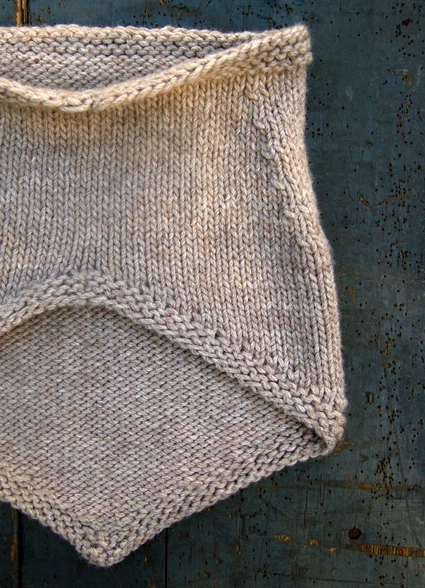
My Bandana Cowl is inspired by my desire to make “effortlessly chic” even more effortless. I was so excited to create something with the same freshness as the tied bandana but without the fiddly aspect of actually having to tie anything!
I chose to make my Cowl out of Swan’s Island Bulky, a brand new yarn made from a beautiful blend of undyed merino and alpaca that feels wonderfully soft against the skin. The yarn creates a dense, rich fabric that’s cuddly perfection for the chilly days of fall!
UPDATE: NOW IN CASHMERE
OCTOBER 14, 2012
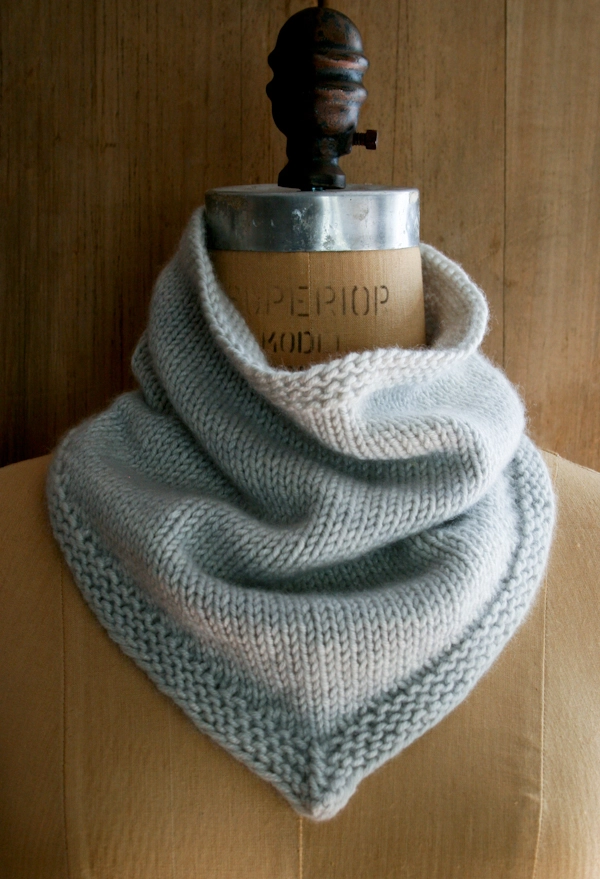
Our original Bandana Cowl is a Purl Bee favorite, knit up in Swans Island beautiful merino Bulky. We love it too! But we couldn’t resist the temptation to get even cozier with the help of Jade Sapphire’s extraordinary 8 Ply 100% Mongolian Cashmere. Carefully selected, gorgeously spun and lovingly hand dyed, it doesn’t really get any better than Jade Sapphire’s cashmere!
UPDATE: NOW IN PLENTY!
MARCH 6, 2022
We revisited this favorite pattern to give it the very special Plenty treatment. As un-scratchy as wool gets, this 100% extra fine merino is soft and squishy with a distinctive spin and very lively bounce. Oh, and it only takes one skein of Plenty to whip up a Bandana Cowl… Casting on now!
UPDATE: BANDANA COWL IN NEW COLORS + STYLES!
SEPTEMBER 2022
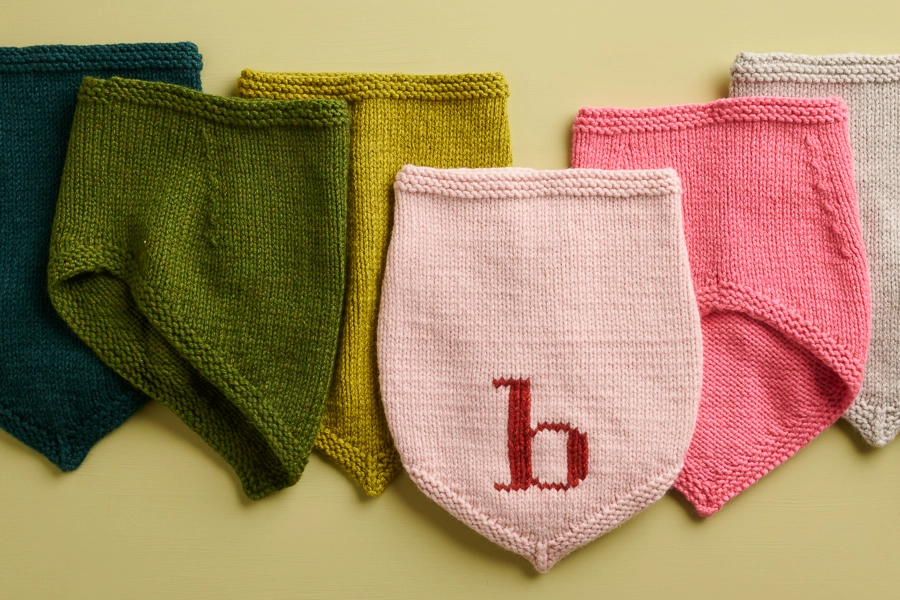
Plenty has so many beautiful colors, we whipped up Bandana Cowls in every one, plus four new colorplay versions, too: Breton Stripes, Transitional Stripes, Colorblock, and even a duplicate stitch Monogram, so you can bring your A game to this knit! (Or your B game!) Cast on to find out why the Bandana Cowl is still one of our most popular knits! Share your progress and connect with the community by tagging your pics with #PurlSoho, #PurlSohoBusyHands, and #PurlSohoBandanaCowl. We can’t wait to see what you make!
Materials
- 1 skein Swans Island Bulky, naturally dyed colors are 100% Organic Merino and undyed colors (Natural, Oatmeal and Seasmoke) are 85% Organic Merino and 15% Alpaca. Each skein is 130 yards/ 100 grams; approximately 130 yards required of Swans Island Bulky or another worsted weight yarn. We used the color Oatmeal.
- A US 10 (6 mm), 16-inch circular needle
- Jumbo Locking Stitch Markers, 3 total (optional)
For a truly cozy cowl, here is another beautiful option:
- 2 skeins of Jade Sapphire’s 8 Ply Cashmere, 100% Mongolian cashmere. Each skein is 100 yards/ 55 grams; approximately 130 yards required.
Gauge
16 stitches and 24 rows = 4 inches in stockinette stitch
Size
Finished Neck Opening: 17¼ inches circumference, comfortably stretching up to 5 inches
Finished Height From Point: 13½ inches
Notes
SPECIAL INSTRUCTIONS
SLIP SLIP KNIT PASS (S2KP)
Slip 2 stitches together knitwise with yarn in back, knit 1, pass the 2 slipped stitches over the knit stitch. [2 stitches decreased]
For more help with this technique, please visit our Slip Slip Knit Pass tutorial.
SHORT ROW SHAPING: WRAP AND TURN (WRP-T)
On the right side: Keeping yarn in back, slip next stitch purlwise from left needle to right needle. Bring yarn to front. Return slipped stitch to left needle. Bring yarn to back. Turn work so wrong side is facing you.
On the wrong side: Keeping yarn in front, slip next stitch purlwise from left needle to right needle. Bring yarn to back. Return slipped stitch to left needle. Bring yarn to front. Turn work so right side is facing you.
For a step-by-step video and photo tutorial of how to work this technique, including how to work wrapped stitches with their wraps, please visit our Short Rows: Wrap + Turn Tutorial tutorial.
Pattern
Cast on 89 stitches. We used a basic Long Tail Cast On.
Place a marker and join for working in the round, being careful not to twist the stitches.
Set-up Round: Purl all stitches.
Round 1: K43, S2KP (see Notes, above), knit to end of round. (87 stitches)
Round 2: P42, S2KP, purl to end of round. (85 stitches)
Round 3: K41, S2KP, knit to end of round. (83 stitches)
Round 4: P40, S2KP, purl to end of round. (81 stitches)
The next section is worked back and forth in short rows, building from the point of the bandana to the back of the neck. You’ll be turning the work between each row instead of continuing around the needle. For a great Short Row Tutorial, click here!
Row 5: K42, wrap and turn.
Row 6: P3, wrap and turn.
Row 7: Knit to the wrapped stitch, knit the wrapped stitch making sure to pick up the wrap, k1, wrap and turn.
Row 8: Purl to the wrapped stitch, purl the wrapped stitch making sure to pick up the wrap, p1, wrap and turn
Repeat Rows 7 and 8 eighteen more times. Don’t worry if you lose count; you’ll know you’re done when you wrap and turn the stitches right next to the marker!
You’ve finished the short rows!
Next Round: With the knit side facing you, knit to the marker, making sure to pick up the wrapped stitch.
Continue with the knit side facing you, working again in the round. Knit 2 rounds, picking up the wrap of the first stitch.
Set-up Round: K18, place marker, k45, place marker, knit to end of round.
*Decrease Round: Knit to two stitches before the first marker, k2tog, slip marker, knit to the next marker, slip marker, ssk, knit to end of round. (2 stitches decreased)
Knit 3 rounds (or for 1/2 inch).
Repeat from * five more times. (69 stitches)
Next Round: Purl
Next Round: Knit
Repeat the last 2 rounds once more.
Bind off very loosely in purl. (I like to go up several needle sizes to bind off. In this case, I bound off with a US #15 needle.)
Weave in your ends and block as desired. Blocking isn’t strictly necessary for this project, but it significantly improves the drape and softness of the yarn. I’m personally convinced that Soak wash makes anything short of a Brillo Pad feel next–to–the–skin cuddly!
Enjoy your Bandana Cowl on all the brisk fall days to come! -Erin


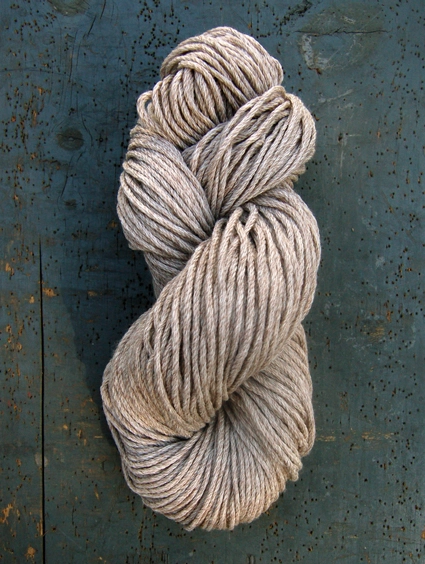


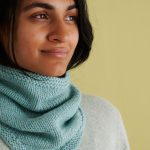
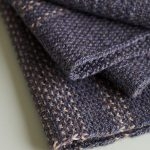
Hi, I am confused about where to start row 5 relative to the point of the bandana. I am using magic loop method and my point is kind of off center on one side of my loop. Before I start row 5 do I need to slide all the stitches onto the cable and find a new starting point for the round? Or, where is the starting point of my first row 5 stitch? Thank you!
Hi Florinda,
Thanks for writing in with your question! I can see how using the magic loop method can be a little bit tricky while doing short row shaping, but you should be able to work these upcoming short rows just fine, especially if you center the point of the bandana on one side of your needles before beginning row 5.
Starting at row 5 you will be working in short rows and not knitting back to your beginning of round marker like in the previous rounds. The point of your bandana should be 40 stitches away from the beginning of round marker, which Row 5 will help establish. After knitting 42 stitches for Row 5, your wrp-t stitch should be just slightly past the point of your bandana (2 stitches past the tip), then you will wrap and turn your work so the wrong side is facing you.
Continuing to Row 6, you will purl 3 stitches before wrapping and turning again. This will bring you back to the other side of your point, which will be perfectly centered between your wrapped stitches.
I hope this helps!
All the best,
Carly
Thank you so much for the reply. I will give this a try. It sounds, though, like magic loop was not the preferred method for this project. What should I have done instead?
Hi Florinda,
Because the circumference of the finished neck opening of this cowl measures 17.25 inches, we recommend using 16-inch circular needles for the project!
All the best,
Lili
Hola no me centra desde la. Vuelta 5. Tejí 42 puntos y gire tejiedo de revez regresé al. Marcador de inicio. Y Tejí 3 puntos y volví a girar. No regresé por el otro lado sino al. Mismo lado donde inicié la prinera fila corta. Ayuda
Hello!
Thank you so much for your question. On Row 5, you will knit 42 stitches to position the beginning of your short rows. Then, you will wrap and turn the 43rd stitch, and begin purling on the wrong side of the work for Row 6. You will turn your work after each row for this short row section! Short rows are only worked across some of the stitches in your row, not all of them, so you are on the right track! If you would like more information about how to work Short Rows, you can check out our tutorial here!
I hope this helps!
All the best,
Margaret
Hi. I am knitting the bandana cowl in beautiful Plenty for the girls in the family. On #2 now. The youngest two would like smaller sized ones. How can I adapt the pattern nicely. Smaller circumference and shorter. They are 11 and 9 years of age. Thanks so much. I am about to order more wool.
Gloria Sternthal
Hi Gloria,
Thank you so much for reaching out, and what a lovely family gift idea! We unfortunately don’t have the resources to rewrite this pattern in different sizes, but if you want to calculate the amount of stitches you will need to cast on for a different size, you will multiply 4 x the desired circumference in inches = amount of cast on stitches.
You will also want to know the halfway point from the begining of round, so that you can have a centered point, and when you begin shortrow shaping, you will want to knit just 1 stitch past that middle stitch before doing your wrap and turn.
I hope this helps!
All the best,
Carly
Hola estoy confundida y no entiendo cuantas vueltas cortas debo hacer… si pierdo la cuenta a qué marcador se supone que debo llegar? Hice vueltas cortas hasta llegar al marcador de inicio y me quedó muy largo.
Hi Jimena,
Thanks for reaching out. It sounds like you’ve done the correct number of short rows! You will work a total of 40 short rows, and you’ll know when you’re done when the wrapped stitches are right next to the stitch marker at the end of the round. Hope this helps clarify things!
All the best,
Lili
I have made 2 Bandana cowl’s and would like to sell them at the Fabric Guild I belong to. Where we dye fibers, spin and weave. also knit and have a sale in November open to the public. Would this be possible ?
Hi Val,
Thank you for your interest in our patterns! While we’re happy you like our Bandana Cowl, our patterns and designs are copyrighted and are for home use only. This means that you can’t use our patterns to make things for sale. We hope you understand!
Thank you for getting in touch!
All the best,
Margaret
Ok so when you get to row 9 it says:
Repeat rows 7&8 eighteen more times. Don’t worry if you lose count, you’ll know you’re done when you wrap and turn the stitches right next to the marker!
What marker? Certainly not the marker from the beginning when it was joined in the round! I can not see where we were instructed to place other markers!
Help!
Hi Claudette,
Thank you for asking! The stitch marker that is indicated in our pattern at this point is indeed the beginning of round marker. Working the short rows in the repeats of rows 7 and 8 will gradually add stitches for progressively longer short rows, meaning that by the time you’ve worked 18 repeats, you will have added all of the stitches on your needles to your “short” rows!
I hope this helps clarify things, and please don’t hesitate to let us know if you have any other questions!
All the best,
Margaret
Hello!
I am new to short rows and I have a question about row 7. Approximately how many knit stitches should I do before coming to the wrapped stitch? I completed rows 5 and 6 and now I am stuck on 7.
Question #2 – On the video it shows picking up the wrapped stitch – at which row does this happen?
Please help! I really like this pattern, but I’ve never done short rows!! Thanks!
Hi Kiana,
That’s a great question! The number of stitches you will knit (or purl) before coming to a wrapped stitch will differ on every row (which is why we don’t specify it in the pattern). Each short row gets progressively longer, so you will need to knit (or purl) 2 more stitches on every repeat. On Row 7, you will knit 3 stitches (since that’s when you reach the wrapped stitch from a previous short row), knit that stitch with its wrap, knit 1 more stitch, and then work the wrap + turn.
In answer to your second question, you will be knitting (or purling) one wrapped stitch on every single short row! This is because each short row is getting longer, so you need to go slightly past the extent of the previous one before wrapping the new wrapped stitch. This is indicated in the pattern by the phrases “knit the wrapped stitch making sure to pick up the wrap” or “purl the wrapped stitch making sure to pick up the wrap.”
I hope this helps clarify things!
All the best,
Lili
I also was confused at row 7 and I’m afraid the response has made me even more confused. Row six says to purl 3, then wrap, then turn. So wouldn’t the very first stitch you work after turning be the wrapped stitch (the last one from row 6)? But the response here makes it sound like the three purl stitches get worked first before coming to the wrapped stitch. I can’t *wrap* my head around this.
Never mind, I reread the wrap and turn instructions, slept on it, and it’s all clear to me now.
Hi Clara,
That’s great news! I’m glad to hear that the short rows are making more sense now.
But in case anyone else has the same question, I’ll write out the answer here: When you turn your work after wrapping the stitch, the wrapped stitch will be on your right needle. Therefore, you will not work it until you come all the way back from the other direction on the next short row!
All the best,
Lili
New knitter here so I apologize for the basic question but how would you suggest adjusting this pattern so that it would fit a teen? Thank you in advance for the asssistance.
Hello,
Thanks for writing in! You can definitely make this pattern a bit smaller to fit a teen. To figure out your cast-on number, you can multiply the number of stitches per inch (4) by the circumference that you would like and cast on the nearest 4 + 1. Then you can follow the pattern as written! You may also want to reduce the height of the cowl, so to do that, just knit fewer rounds in the DECREASE TO TOP section. Hope this helps!
All the best,
Lili
How many stitches should there be after all of the short rows are finished?
Thank you!
Hi Christine,
Thanks for reaching out. After you complete the short rows, there should still be 81 stitches on your needles! The short rows ultimately do not decrease any stitches, so this is the same number you should have right before beginning the short rows (but after the s2kp decreases). Hope this helps!
All the best,
Lili
Oh dear….somehow I have 87…would it be ok to k2tog six times on my next row to get back to 81?
Thanks!
Oh no! I think that decreasing 6 times on one row might cause the fabric to pucker a bit, so I wouldn’t recommend that. Instead, I’d recommend proceeding to the decrease section, but working the Decrease Round after every 2 rounds instead of after every 3 rounds (and also working more repeats of the Decrease Round in total). That way, you can decrease down to the correct stitch count in a smoother manner.
All the best,
Lili
Hi – I’ve been looking closely at the point shaping in your photos. Some have used the S2KP method. But others have a neat vertical column of about 4 knit stitches instead. Not sure how this was done. Why is that method not included in the pattern? I much prefer it as it looks very neat.
Hi Colleen,
Thanks for reaching out. The s2kp method will create a column of 4 knit stitches at the point of the cowl! I do see what you mean that one of our photos doesn’t show this column, and that’s likely because there was an error in the process of knitting it up. We’re so sorry for the confusion! If you take a look at our most recent samples, they should all have the correct s2kp shaping! (Unless they’re photographed from the wrong side, in which case the correct shaping is there, just not visible!)
All the best,
Lili
Eek I have 85 stitches for some reason at the end of my short rows…and not sure how to proceed. I am reaching the marker at the end of a purl short rows, and the be stitch before the marker is the one I picked up the wrap. Help!
Hi Joanne,
Thanks for reaching out, although I’m sorry to hear that you have a few extra stitches on your needles! This is actually pretty easy to fix in this pattern. What you can do is continue following the pattern as written, but add a 2 more Decrease Rounds to reduce the stitch count by 4. You can also space these Decrease Rounds closer together, so that the cowl comes to the same height as intended!
All the best,
Lili
I was given 2 skeins of the Jade Sapphire 6 ply…gorgeous! I’ve done this cowl a couple of times. How would you modify it for the 6 ply v the 8 you reference above? Could I possibly get by with just one skein? Or is there another cowl pattern that would be a better fit?
Hi Rosemary,
Thanks for reaching out. To modify this pattern for a lighter weight yarn, you will need to change the stitch count so that it comes to the correct dimensions with the different gauge!
To figure out your cast-on number, you will want to first knit a gauge swatch in pattern (if this is daunting, we have a wonderful tutorial called All About Gauge). Once you know how many stitches you are getting per inch, you can multiply that number by the lower circumference of the cowl (22.25 inches) and cast on the nearest multiple of 4 + 1. Then you can essentially follow the pattern as written!
The only other things you’ll want to keep in mind are A) the column of s2kp decreases (and the beginning of the short rows) should be centered in the middle front of the cowl, B) you’ll end up repeating Short Rows 3 and 4 more than 18 more times, so that they extend until the end-of-round marker, and C) you may want to place the decreases in the DECREASE TO TOP section in slightly different places so that they’re proportional to the cast-on number.
Hope this helps!
All the best,
Lili
Hi Lili,
Can you please tell me how to adjust the bandana cowl pattern for your Cashmere Merino Bloom.
If I cast on 100 stitches, instead of 89, how would I follow the pattern?
Many thanks,
Dale
Hi Dale,
Thanks for writing in! To alter this pattern for a different cast-on number, you’ll need to first make sure that that number is a multiple of 4 + 1. So you’ll need to begin with 101 stitches instead! Once you cast on 101, stitches, here’s how to follow the subsequent decrease rounds:
Set-up Round: Purl all stitches.
Round 1: K49, S2KP (see Notes, above), knit to end of round. (99 stitches)
Round 2: P48, S2KP, purl to end of round. (97 stitches)
Round 3: K47, S2KP, knit to end of round. (95 stitches)
Round 4: P46, S2KP, purl to end of round. (93 stitches)
Then, you’ll move onto the short row section, beginning with this:
Row 5: K48, wrap and turn.
From here on out, you can essentially follow the pattern as written, keeping in mind two small things! 1) You’ll need to repeat Rows 7 and 8 more than eighteen more times, since you have more stitches. Just keep repeating these rows until you’ve wrapped both of the stitches directly adjacent to the end-of-round marker! 2) Once you reach the decrease rounds, you may want to space the columns of decreases differently to accommodate the different stitch count. But this is optional and won’t really affect the finished cowl!
All the best,
Lili
Thanks so much Lili! Your help has been amazing. I finally did learn the short row technique and made several bandana cowls for Christmas! Couldn’t have done it without you!
I did make one with Cashmere Merino Bloom, using the regular pattern, but it’s a bit tight, so your instructions will be great! I love the Cashmere Merino.
Thank you again for your patience!
Dale
You’re very welcome, Dale!
All the best,
Lili
I am a continental knitter, and I have knit about a dozen cowls with your pattern or a variation of it, based on the yarn I am using. I love this pattern so much! One issue I have not been able to resolve is that my short row section looks a little choppy. I believe my tension is different between my knit rows and my purl rows. Have you experienced this, and do you know how to address it? I do not know if my knits are looser than my purls, or if my purl rows are looser than my knits. What is typical? Once I finish the short rows and begin working in the round, the fabric is lovely and smooth.
Hi Melissa,
Thanks for writing in! Uneven tension when knitting flat is a very, very common thing that many knitters experience. The culprit is typically that the purl rows (the wrong side short rows, in this case) are looser than the knit rows. We’ve found that blocking your cowl after finishing it can minimize the tension differences, so I’d recommend trying that if you haven’t already!
Alternatively, if you’re up for it, you could go down a needle size for just the purled short rows. That should bring the two tensions closer together!
You may also want to look into some other styles of purling, such as Norwegian purling, or even doing English style knitting for just the purled rows. Some of my coworkers have explored these alternate purling methods, and they highly recommend giving them a try! I’d just suggest trying these out on a separate swatch first before you use them in a project.
I hope this helps, and please let me know if you have any other questions!
All the best,
Lili